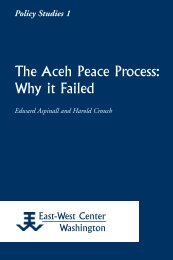Constructing Papuan Nationalism: History, Ethnicity ... - ScholarSpace
Constructing Papuan Nationalism: History, Ethnicity ... - ScholarSpace
Constructing Papuan Nationalism: History, Ethnicity ... - ScholarSpace
- No tags were found...
Create successful ePaper yourself
Turn your PDF publications into a flip-book with our unique Google optimized e-Paper software.
<strong>Constructing</strong> <strong>Papuan</strong> <strong>Nationalism</strong> 57ment of a pan-Indies consciousness among future Indonesians. Indeed,this promotion of a <strong>Papuan</strong> identity was one of the objectives of Dutchpolicy in the post-war years.By the early 1960s, the colonial educational institutions had alreadyproduced a new local elite, many of whose members were actively involvedin formulating a distinctively <strong>Papuan</strong> nationalism. The institutions andprocesses of social change were much the same as those which had producedan earlier generation of Indonesian nationalists. In his 1961 studyof the emerging <strong>Papuan</strong> political elite, Grootenhuis observed that themore progressive and better-educated members of that elite, such as theleaders of PARNA, were moving out of the milieu of their own ethno-linguisticgroup into greater contact both with <strong>Papuan</strong>s from other regionsand with non-<strong>Papuan</strong>s. Many of the PARNA leaders were men from Seruiwho were the first members of their family to enjoy an education higherthan village primary school. Many had moved to Hollandia, where theytended to live in Hamadi among <strong>Papuan</strong>s of diverse backgrounds. Therethey were active in community organizations such as trade unions andyouth and sports groups, where they also came into regular contact withDutch residents of Hollandia. In addition, these men read the local newspapersand listened to radio broadcasts of the Dutch government and fromIndonesia. Nevertheless, Grootenhuis argued that these PARNA membershad taken but the first step out of their local milieu. For example, thoughthey lived among people of diverse backgrounds in Hollandia, their spouseswere mostly from their own group. 93 PARNA sought to unite all<strong>Papuan</strong>s and create a national identity, yet its leaders were still bound upin their own ethno-linguistic group.Nevertheless, PARNA’s very existence was a step in the direction ofnationhood. Indeed, its very name (Partai Nasional, or National Party)suggests that PARNA sought to unite all <strong>Papuan</strong>s in a common nationalidentity. 94 Nevertheless, the region-specific nature of PARNA’s leadership,and the expression this gave to Papua’s regional divisions, drew commentfrom the journalists of the day. For example, in 1960 the Catholic weeklyTifa published an article, entitled “Nationaal Partai,” which noted that allthe PARNA leaders were from Serui and that none were from Biak. Thearticle went on to observe that the struggle between Biak and Serui was theoldest in <strong>Papuan</strong> politics. After the Pacific War, for example, MarkusKaisiepo, from Biak, had been the leading pro-Dutch politician, whileSilas Papare, from Serui, led the pro-Indonesia forces. 95 Regional rivalries
















